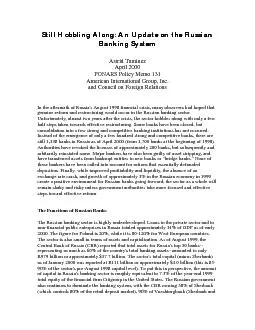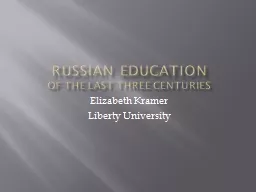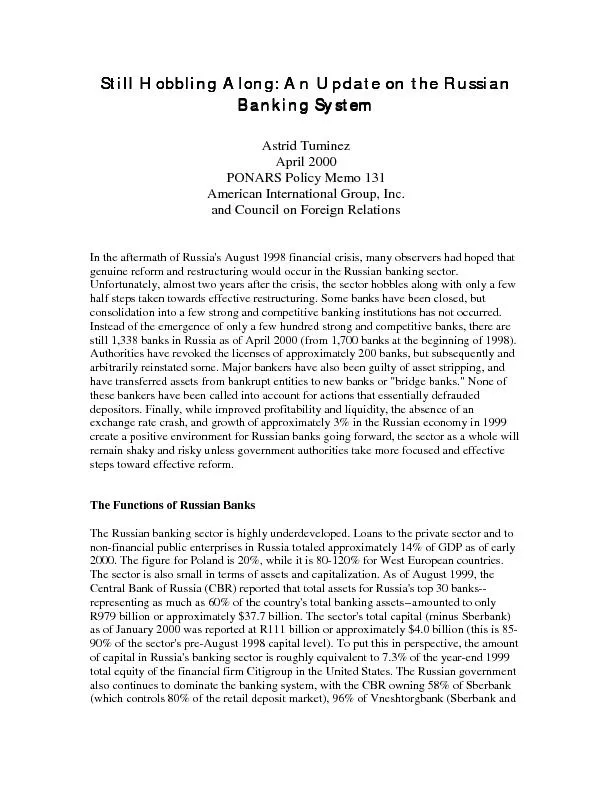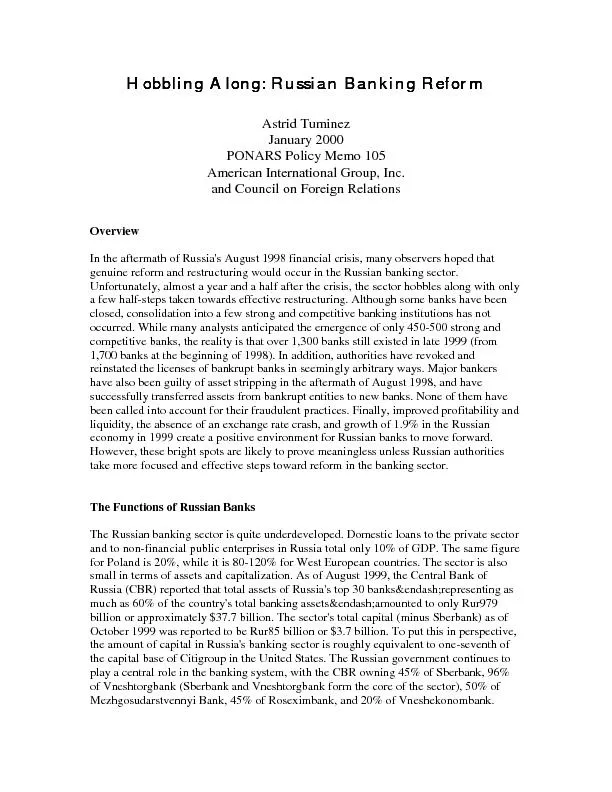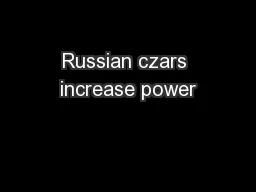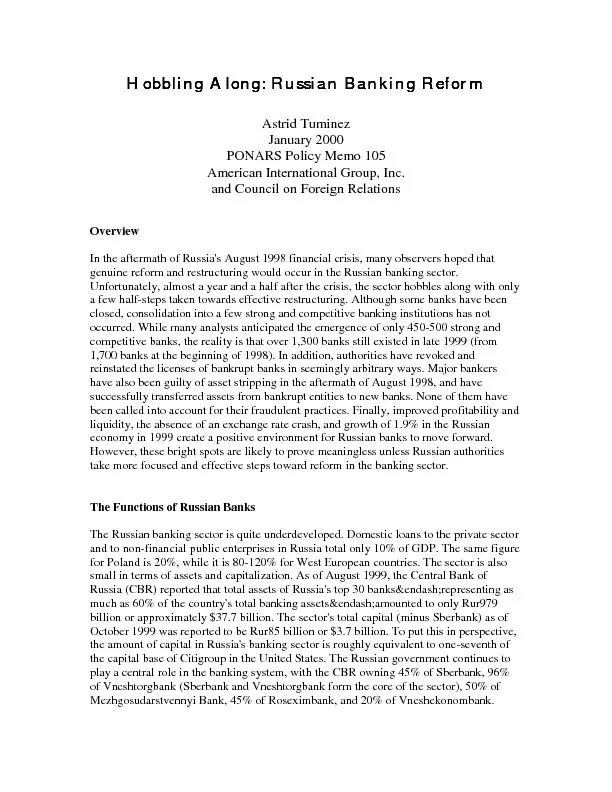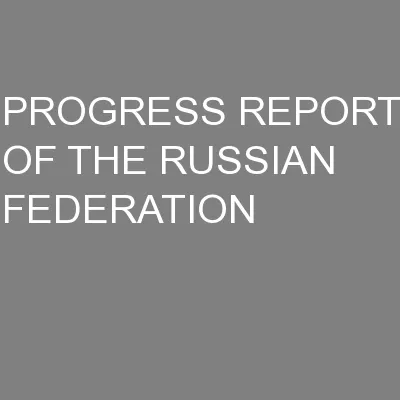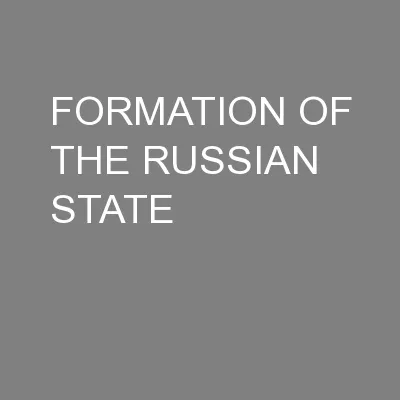PDF-Still Hobbling Along: An Update on the Russian Still Hobbling Along: A
Author : marina-yarberry | Published Date : 2015-08-07
Program on New Approaches to Russian Security Tuminez 2 Vneshtorgbank together control 30 of the sectors assets 50 of Mezhgosudarstvenny Bank 45 of Roseximban
Presentation Embed Code
Download Presentation
Download Presentation The PPT/PDF document "Still Hobbling Along: An Update on the R..." is the property of its rightful owner. Permission is granted to download and print the materials on this website for personal, non-commercial use only, and to display it on your personal computer provided you do not modify the materials and that you retain all copyright notices contained in the materials. By downloading content from our website, you accept the terms of this agreement.
Still Hobbling Along: An Update on the Russian Still Hobbling Along: A: Transcript
Program on New Approaches to Russian Security Tuminez 2 Vneshtorgbank together control 30 of the sectors assets 50 of Mezhgosudarstvenny Bank 45 of Roseximban. Russian Martial Art: ROSS Seminar Saturday, August 7 from 10am to 4pm Contact: Arthur Rowell Phone (601) 410-0732 Email: adrowell@gmail.com of the Last Three Centuries. Elizabeth Kramer. Liberty University. Nineteenth Century. Tsarist Abolitionism. Nicholas I. Indoctrination. Autocracy. Orthodoxy. Nationalism. Principles of Tsarist Autocracy. . Pre-Revolutionary Russia. Only true autocracy left in Europe. No type of representative political institutions. Nicholas II became tsar in 1884. Believed he was the absolute ruler anointed by God. Program on New Approaches to Russian Security Tuminez 2 Vneshtorgbank together control 30% of the sector's assets), 50% of Mezhgosudarstvenny Bank, 45% of Roseximban Program on New Approaches to Russian Security Tuminez 2 Unlike in most developed economies, where banks' central role is that of financial intermediation (i.e., mobi , . traditions. . and holidays . Russian people. Almost every nation and country has a reputation of some kind. The Englishmen are reputed to be cold, reserved, rather naughty easy-going and fond of sport. They are the nation of stay-at-homes. «There is no place like home», they say.We know much about English traditions and customs but now I’d like to say a few words about the traditions of my native land-Russia. First, about Russian people. To my mind, the main traits of their characters which differ them from other people are hospitality, their «open heart», «golden hands», wise Russian fairytales reflect this wisdom. Our people are hardworking, patient, never loosing hope for better life. The Russians are the talented nation. Russia gave the world beautiful names of Pushkin and Lermontov, Chaikovsky and Repin, thousands of names of world famous poets, writers, composers, scientists. All of them are the pride of the nation because they sand the beauty of our nature and people. . 5Date ProblemsSolutions 1.Russian people did notnecessary. 2.The Russian Orthodox 3.The great landowners hadtoo much power. 4.The Russian army was 5.Russian society had to 6.To promote education andse The Role of Women. Pre-Reading Question. “Women are emotional and irrational in character, whereas men are logical and rational.”. Agree/Disagree. . Write a brief exploration of why.. Vocabulary. Program on New Approaches to Russian Security Tuminez 2 Unlike in most developed economies, where banks' central role is that of financial intermediation (i.e., mobi . PROJECT . “ARCTIC RESCUE”. 2013. EPPR. Emergency Prevention, Preparedness . and Response. "The Issues of Emergency Management in the Arctic. Oil Spills Prevention and Response”. EMERCOM of Russia hosted the International conference "The Issues of Emergency Management in the Arctic. Oil Spills Prevention and Response” in the city of Naryan-Mar, August 20-22 , 2013.. RUSSIAN INGREDIENTS. OR. “WHO ARE THE RUSSIANS?”. FORMATION OF THE RUSSIAN STATE. V. RUSSIA GETS A LANGUAGE: CYRIL AND METHODIUS C. 800’S A.D.. A.. B.. C.. D.. CYRILLIC ALPHABET. FORMATION OF THE RUSSIAN STATE. A Writer’s Reflection. Reflections and thoughts from the article:. “Futurists and Others in Famished Moscow:. Radical Artists Find New Manners of Expression Amid Social Chaos”. By Oliver M. Sayler. Traditions of our country.. . School . №. 31. . Kargapoltseva. A. V.. Tea was introduced to Russia in the early seventeenth century by China.. Prior to its introduction in Russia, the drink of choice . La gamme de thé MORPHEE vise toute générations recherchant le sommeil paisible tant désiré et non procuré par tout types de médicaments. Essentiellement composé de feuille de morphine, ce thé vous assurera d’un rétablissement digne d’un voyage sur .
Download Document
Here is the link to download the presentation.
"Still Hobbling Along: An Update on the Russian Still Hobbling Along: A"The content belongs to its owner. You may download and print it for personal use, without modification, and keep all copyright notices. By downloading, you agree to these terms.
Related Documents

